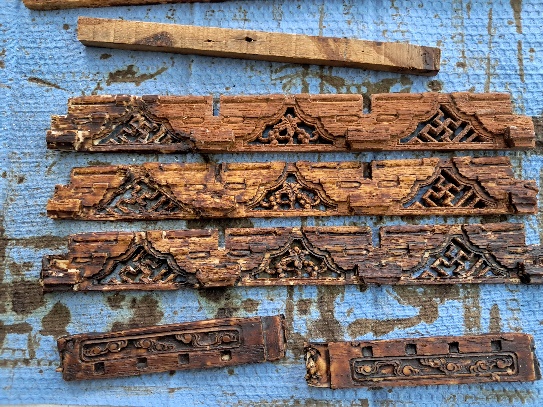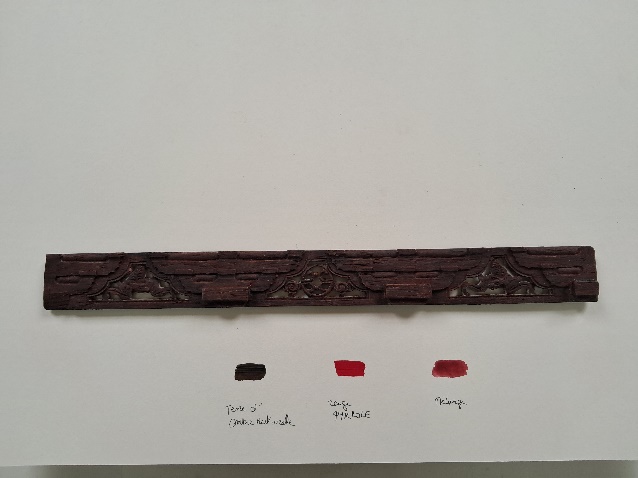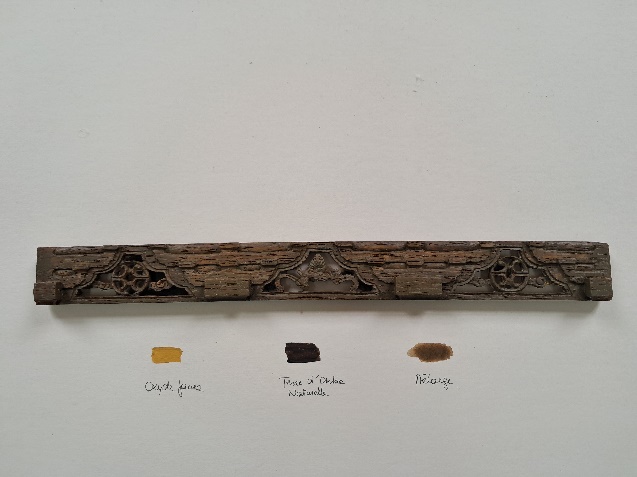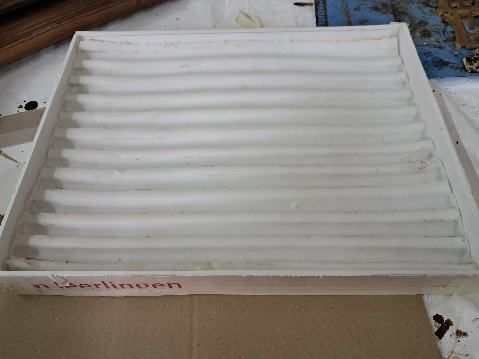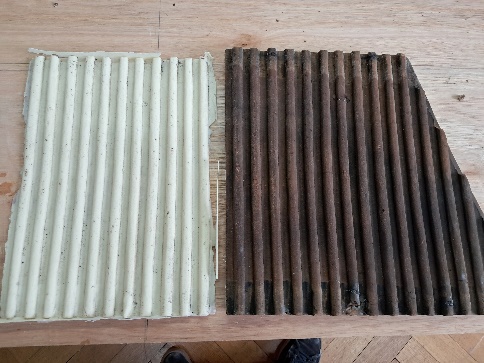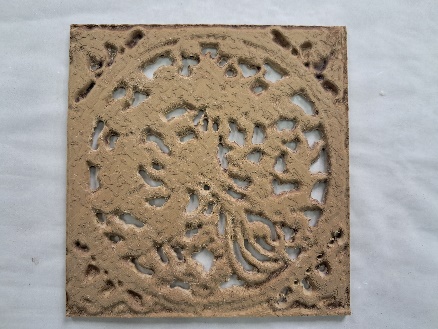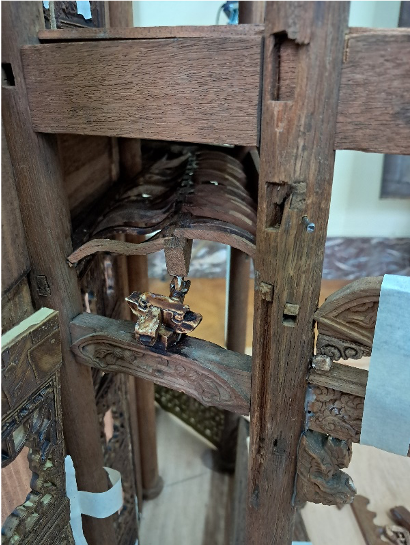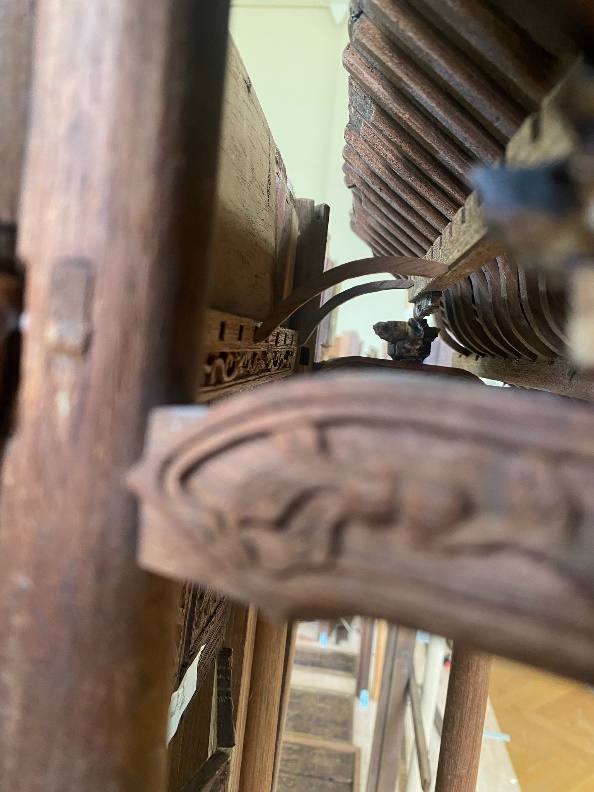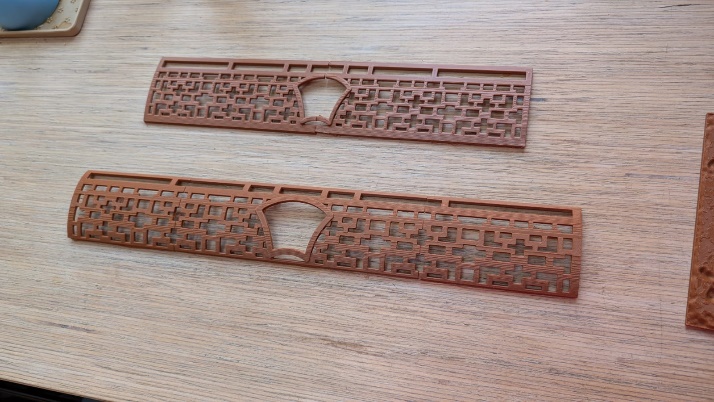We start the week by preparing for the steering committee meeting with tests of different colors.
We are creating a mold for the missing roof tiles using the large section of the roof in our possession. This will allow us to create the missing wooden pieces and apply the tile pattern in resin. We cast in resin and achieve an encouraging result.
We receive a visit from Gwenaëlle de Spa, who shows us the progress of the sculpted medallions on the central facade. She also created the small ground-floor railings that connect the side sections to the central section.
We drill the medallion holes by hand, as the print files are too large to achieve the desired result.
On April 15, the steering committee, established after the visit of representatives from the King Baudouin Foundation, met. The minutes are as follows:
|
Minutes of the Steering Committee Meeting for the Restoration of the Chinese Palace Model April 15, 2025, Royal Museums of Art and History Attendees:
The meeting begins with a presentation of the historical context and the few available historical references for the model (Tushanwan archives fire in 1919, absence of similar models, etc.). Diane Hennebert reminds attendees that the main topics for discussion concern potential polychromy to be applied, the overall color unity, the choice of base color, the rear closure, and potential interior lighting for the model. Valentine Henderiks raises the question of the frieze on the roof edges of the model. Indeed, the available pieces show a frieze composed of faces, with significant missing sections. To avoid excessive restoration, it is unanimously decided to place the existing parts and not to create new ones to fill the gaps. The restorers present paint samples to differentiate new pieces from original ones. They also present gilded or yellow samples for pieces that, in old photographs, appear to indicate a lighter tone. Marianne Decroly suggests a lighter shade to distinguish the new pieces, as the presented samples are all quite dark. The guiding principle for the restoration is to adhere as closely as possible to period photographs. Distinguishing new pieces, in addition to adding polychromy, risks compromising the model’s legibility, especially since this model cannot be considered a work of art. To respect the light/dark contrasts in the photos, Nathalie Vandeperre suggests leaving the 3D-printed filament parts in a lighter shade and without patina. Indeed, the filament chosen for the printed pieces is lighter than the model’s original wood and also lighter than the patina applied to the various pieces created so far. It is decided to continue the restoration without patinating these pieces. It will be decided at the end of the overall reconstruction whether an additional tint should be added to the varnish of these pieces. The color of the model’s base is also discussed: it is proposed to apply a walnut stain wash to achieve a tone similar to the contrasts observed in the photograph from architect Alexandre Marcel’s archives. Regarding the model’s interior lighting, the question of fixing light sources from the base is raised. Nathalie Vandeperre suggests the possibility of placing multiple light points inside the model to give it a more vibrant appearance. Tests can be carried out once the restoration work is more advanced. Regarding the rear of the model and based on old photographs, an absence of transparency is observed in the central part, suggesting that the model was closed at the back, either by fabric or by a board. The option of a wooden closure is chosen. The height of the base is also discussed. It is decided that the final base will be 85 cm high. This base will consist of three fitted parts, facilitating the transport and movement of the model. It is desirable that this base also be equipped with wheels for potential movement, once the model is installed in the annex of the Chinese Palace. Valentine Henderiks mentions the fragility of such a device and the question of cleaning and maintaining the model once its restoration is complete. It is decided not to provide a display case for the model due to technical and dimensional reasons. As a reminder, this model is not a work of art, even if spectacular, and was created to be presented to King Leopold II. The meeting concludes with the suggestion of presenting the model within the Royal Museums of Art and History, along with a selection of Chinese Palace furniture currently in the museum’s reserves. This idea, though appealing, needs to be submitted to the museum’s management soon. The restorers thank the committee members for their advice and decisions. A new meeting can be scheduled if further questions arise that require resolution. |
We are completing the positioning of the hundred “S” and “C” elements under the balconies.
We are attempting to position the “S” and “C” elements under the roofs.
We are molding the sculpted trim to be placed in front of the balcony floor.
By comparing the plans from the Shanghai Notebook and the plans of the existing building situation, we are able to define the dimensions of the pillars for the central facade structure, as well as the positioning depth of the doors on the sides of the central facade.
 We are cutting the pillars to size for the central section’s structure.
We are cutting the pillars to size for the central section’s structure.
With Gwenaëlle de Spa, we are defining the fan shape of the first-floor balcony railings. Previous tests yielded shapes too far removed from the photograph in the Shanghai Notebook.
We are finishing the placement of the notched strips that will receive the “S” and “C” elements on the first floor of the side sections.
We are continuing the staining of the friezes and the “pineapples” on the roof ends.
To address adhesion problems between the silicone and the plaster counter-mold of the roof piece, we are scheduling an appointment for Tuesday, April 22, with Thierry, a manager of the museum’s molding workshops.
